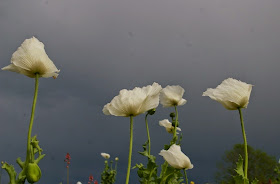 |
| Sea Bindweed Calystegia soldanella at Spurn Head |
 |
| Sea Bindweed in classic habitat at the edge of sand dunes. |
I only know of one person who encourages bindweed in her garden, but she is rich enough to do what she pleases; the rest of us dread it. But set the fear and loathing aside and look at it objectively, if you can, and appreciate the real beauty of the flowers, with their perfect trumpets and finely furled buds. If, as gardeners say, they were rare and difficult to grow, we would lust after them, valuing them as we do morning-glories,
Ipomoea.
Yesterday I visited Spurn Head, the strange narrow spit of land that protrudes from the easternmost corner of the East Riding of Yorkshire into the Humber estuary, and found three species of bindweed growing in the sand dunes; the two common, nuisance-causing species Hedge Bindweed
Calystegia sepium and Field Bindweed
Convolvulus arvensis, and the much more refined and interesting Sea Bindweed
Calystegia maritima. This is a strictly coastal plant, usually growing in sparsely vegetated sand dunes, though apparently it can occur in shingle too, usually with prostrate stems, small fleshy leaves and pink-and-white flowers. No doubt the rhizomes run through the dunes, but it doesn't seem to be an aggressive plant. I've never seen it in cultivation - probably because of the generic reputation but I wonder if its maritime distribution is due to a degree of tenderness - after all, Convoluvulaceae is very largely a tropical family, with few temperate outliers.
 |
| The familiar white trumpets of the dreaded Hedge Bindweeed, Calystegia sepium, but here in the dunes the plant had taken on a rich red tinge that set off the flowers very well. |
 |
| A pallid form of Field Bindweeed Convolvulus arvensis, another devil to be avoided at all costs in the garden, but actually very pretty. |
For those who may look at their bindweeds before trying to eradicate them,
Calystegia is most easily distinguished from
Convolvulus by the pair of bracteoles that envelop the base of the flower, concealing the calyx below them: they are clearly visible in the image of
C. sepium.
Convolvulus lacks the bracteoles, and (usually) has blunt calyx lobes and a linear stigma, while
Ipomoea has pointed calyx lobes and a globose stigma (according to C. Stace,
Flora of the British Isles, 2010).
































